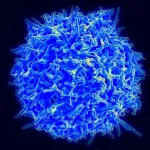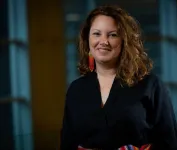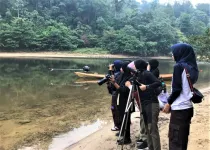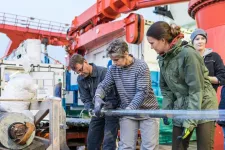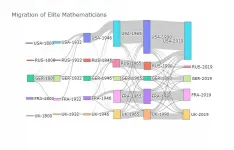(Press-News.org) Physicists from the University of Sussex have developed an extremely thin, large-area semiconductor surface source of terahertz, composed of just a few atomic layers and compatible with existing electronic platforms.
Terahertz sources emit brief light pulses oscillating at 'trillion of times per second'. At this scale, they are too fast to be handled by standard electronics, and, until recently, too slow to be handled by optical technologies. This has great significance for the evolution of ultra-fast communication devices above the 300GHz limit - such as that required for 6G mobile phone technology - something that is still fundamentally beyond the limit of current electronics.
Researchers in the Emergent Photonics (EPic) Lab at Sussex, led by the Director of the Emergent Photonics (EPic) Lab Professor Marco Peccianti, are leaders in surface terahertz emission technology having achieved the brightest and thinnest surface semiconductor sources demonstrated so far. The emission region of their new development, a semiconductor source of terahertz, is 10 times thinner than previously achieved, with comparable or even better performances.
The thin layers can be placed on top of existing objects and devices, meaning they are able to place a terahertz source in places that would have been inconceivable otherwise, including everyday object such as a teapot or even a work of art - opening up huge potential for anti-counterfeiting and 'the internet of things' - as well as previously incompatible electronics, such as a next generation mobile phone.
Dr Juan S. Totero Gongora, Leverhulme Early Career Fellow at the University of Sussex, said:
"From a physics perspective, our results provide a long-sought answer that dates back to the first demonstration of terahertz sources based on two-colour lasers.
"Semiconductors are widely used in electronic technologies but have remained mostly out of reach for this type of terahertz generation mechanism. Our findings therefore open up a wide range of exciting opportunities for terahertz technologies."
Dr Luke Peters, Research Fellow of the European Research Council project TIMING at the University of Sussex, said:
"The idea of placing terahertz sources in inaccessible places has great scientific appeal but in practice is very challenging. Terahertz radiation can have a superlative role in material science, life science and security. Nevertheless, it is still alien to most of the existing technology, including devices that talk to everyday objects as part of the rapidly expanding 'internet of things'.
" This result is a milestone in our route to bring terahertz functions closer to our everyday lives."
Lying between microwaves and infrared in the electromagnetic spectrum, terahertz waves are a form of radiation highly sought in research and industry. They have a natural ability to reveal the material composition of an object by easily penetrating common materials like paper, clothes and plastic in the same way X-rays do, but without being harmful.
Terahertz imaging makes it possible to 'see' the molecular composition of objects and distinguish between different materials. Previous developments from Prof Peccianti's team showcased the potential applications of terahertz cameras, which could be transformative in airport security, and medical scanners - such as those used to detect skin cancers.
One of the biggest challenges faced by scientists working in terahertz technology is that what is commonly accepted as an 'intense terahertz source' is faint and bulky when compared with, for example, a light bulb. In many cases, the need for very exotic materials, such as nonlinear crystals, makes them unwieldy and expensive. This requirement poses logistical challenges for integration with other technologies, such as sensors and ultrafast communications.
The Sussex team have overcome these limitations by developing terahertz sources from extremely thin materials (about 25 atomic layers). By illuminating an electronic-grade semiconductor with two different types of lasers light, each oscillating at different frequency or colour, they were able to elicit the emission of short bursts of Terahertz radiation.
This scientific breakthrough has been long-sought by scientists working in the field since the first demonstration of terahertz sources based on two-colour lasers in the early 2000s. Two-colour terahertz sources based on special mixtures of gas, such as nitrogen, argon or krypton, are among the best performing sources available today. Semiconductors, widely used in electronic technologies, have remained mostly out of reach for this type of terahertz generation mechanism.
INFORMATION:
The research was developed within the framework of the European Research Council project "TIMING".
The full research paper, titled, 'All-Optical Two-Color Terahertz Emission from Quasi-2D Nonlinear Surfaces' is published in the four star journal, Physical Review Letters, and can be read in full here: https://journals.aps.org/prl/abstract/10.1103/PhysRevLett.125.263901
People are adept at discerning most of the different emotions that underlie screams, such as anger, frustration, pain, surprise or fear, finds a new study by psychologists at Emory University. Screams of happiness, however, are more often interpreted as fear when heard without any additional context, the results show.
PeerJ published the research, the first in-depth look at the human ability to decode the range of emotions tied to the acoustic cues of screams.
"To a large extent, the study participants were quite good at judging the original context of a scream, simply by listening to it through headphones without any visual cues," says Harold Gouzoules, Emory professor of psychology and senior author of the study. ...
WHAT:
When variants of SARS-CoV-2 (the virus that causes COVID-19) emerged in late 2020, concern arose that they might elude protective immune responses generated by prior infection or vaccination, potentially making re-infection more likely or vaccination less effective. To investigate this possibility, researchers from the National Institute of Allergy and Infectious Diseases (NIAID), part of the National Institutes of Health, and colleagues analyzed blood cell samples from 30 people who had contracted and recovered from COVID-19 prior to the emergence of virus variants. They found that one key player in the immune response to SARS-CoV-2--the CD8+ T cell--remained active against the virus.
The research team was led by NIAID's Andrew Redd, Ph.D., and included ...
Indigenous traditions often place land at the centre of their cultures. However, with more than half of Canada's Indigenous population now living in urban areas and Indigenous communities struggling to overcome legacies of colonialism defined by assimilation and land theft, that connection is getting frayed.
Elizabeth Fast, an associate professor of applied human sciences in the Faculty of Arts and Science, wanted to help Indigenous youth reconnect with their cultures in safe and accessible ways. Along with a youth advisory group composed of Indigenous youth (some of whom are also students), she has been organizing a series of land-based learning retreats ...
BOSTON - (March 25, 2021) - A mechanism has been identified that explains how physical exercise in pregnancy confers metabolic health benefits in offspring. According to researchers, the key lies with a protein called SOD3, vitamin D and adequate exercise, with the outcomes possibly forming the first steps to designing rational diet and exercise programs to use during pregnancy and particularly when mothers may also be overweight or obese.
The study, which was led by authors from the Joslin Diabetes Center at the Harvard Medical School and colleagues from Japan, the US, Canada and Denmark, has been published online by Cell Metabolism.
"We've known for a while that risks for obesity and type 2 diabetes can originate in the critical ...
In a new study published in Conservation Science and Practice, researchers at the University of Maryland (UMD) partnered with Indonesian experts to explore the motivations and challenges of women pursuing a career in conservation sciences in Indonesia. Given that Indonesia is one of the most biodiverse countries on the planet but is simultaneously experiencing extreme rates of deforestation, it is an important target country for the conservation of global biodiversity. Conservation work remains male-dominated in Indonesia, especially fieldwork, so gaining a better understanding of the cultural norms and barriers in place for Indonesian women aspiring to a career in conservation represents an important step in supporting women ...
Researchers from Newcastle University, UK, working with colleagues at King Mongkut's University of Technology Thonburi (KMUTT) in Thailand and the Institute of Urban Environment of the Chinese Academy of Sciences, analysed samples of water and sediment taken from aquaculture ponds and nearby canals at five locations in central Thailand's coastal region.
The research, which was part-funded by an institutional links grant awarded by the Newton Fund via the British Council, and which has been published in the Journal of Hazardous Materials, found that the highest prevalence of antimicrobial resistance (AMR) genes was in water ...
Gas hydrates are a solid compound of gases and water that have an ice-like structure at low temperatures and high pressures. Compounds of methane and water, so-called methane hydrates, are found especially at many ocean margins - also in the Black Sea. In addition to a possible use as an energy source, methane hydrate deposits are being investigated for their stability, as they can dissolve with changes in temperature and pressure. In addition to releases of methane, this can also have an impact on submarine slope stability.
During a six-week expedition with the German research vessel METEOR in autumn 2017, a team from MARUM and GEOMAR investigated a methane hydrate deposit in the deep-sea fan of the Danube in the western Black Sea. During ...
Most businesses were ill-prepared to deal with the pandemic and muddled though the challenges stemming from it, according to a report published today.
Resilience reimagined: a practical guide for organisations was produced by Cranfield University, in partnership with the National Preparedness Commission (NPC) and Deloitte. The report presents insights from business leaders from a range of sectors and makes seven recommendations for organisations on how to become more resilient, drawing on lessons from past 12 months.
Cranfield University's Professor David Denyer and Mike Sutliff conducted in-depth interviews and four focus groups with more than 50 C-suite level people (boards, senior executives, policymakers, and resilience directors) from FTSE 100 companies, ...
As social media platforms like Instagram, Snapchat, TikTok and others continue to grow in popularity, adolescents are spending more of their time online navigating a complex virtual world.
New research suggests that these increased hours spent online may be associated with cyberbullying behaviors. According to a study by the University of Georgia, higher social media addiction scores, more hours spent online, and identifying as male significantly predicted cyberbullying perpetration in adolescents.
"There are some people who engage in cyberbullying online because of the anonymity and the fact that there's no retaliation," said Amanda Giordano, principal investigator of the study and associate professor in the UGA Mary Frances Early College of Education. "You have these ...
Math's top prize, the Fields Medal, has succeeded in making mathematics more inclusive but still rewards elitism, according to a Dartmouth study.
Published in Nature's END ...

